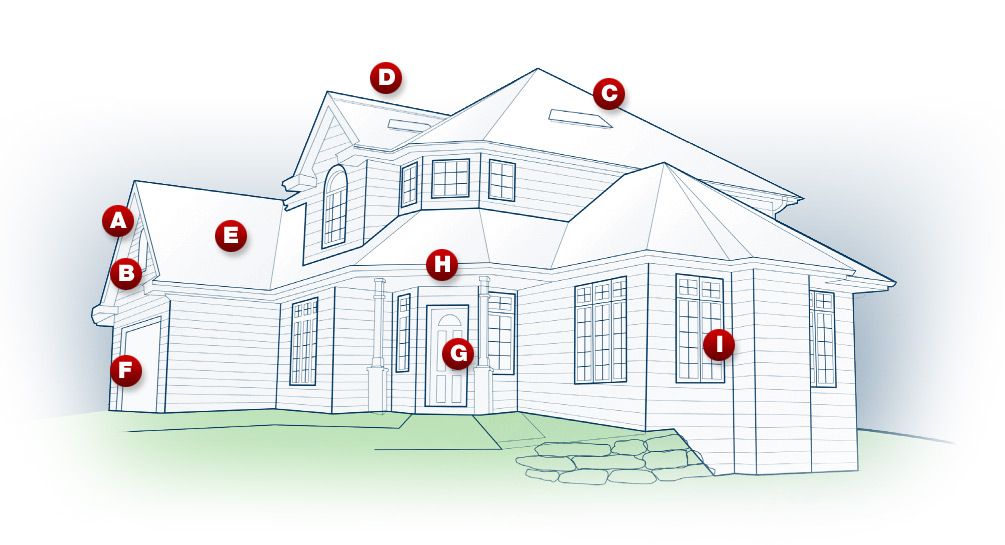The coastal area from Texas to Maine is home to tens of millions of people with $10 trillion worth of insured property that is exposed to the threat of hurricanes. Building science research has identified the areas of a home most vulnerable during hurricanes. This brochure provides guidance for strengthening these areas, which will lead to reduced risk of damage and fewer repairs.

[ A ] Gable Ends
- Overhangs – If greater than 12-in. wide, overhang framing members often need to have the connections improved to the wall framing below using metal connectors. Gable overhang panels should not be perforated (vented) in order to reduce wind-driven water intrusion.
- Gable End Vertical Face – make sure the vertical face of the gable end has structural sheathing attached to prevent it from being
blown off in high winds. - Bracing the Gable Wall – Frequently it is necessary to improve the strength of the gable end wall structure to horizontal wind by adding bracing and strengthening connections.
[ B ] Gable End Vents
If vents are present in the gable end wall for attic ventilation, steps should be taken to cover the vents before a storm hits to keep large quantities of water from being driven into the attic. Use plywood or other flat sheet shutters to seal the opening or consider replacing existing vents with a product rated for resistance to wind-driven rain.
[ C ] Off-ridge Vents
Consider replacing any off-ridge vents not rated for compliance with TAS 100 (A), a high wind and wind-driven rain resistance test; consult a reputable roofer and ask for products that meet TAS 100(A).
[ D ] Ridge Vents
Ridge vents are the last thing installed when the roof covering is put on so they can be easily replaced. Choose vents rated for water intrusion resistance in high winds; look for products that meet TAS 100(A). Install in accordance with manufacturer’s high wind installation requirements.
[ E ] Roofs
When having new roofing installed choose a high wind rated system. When re-roofing:
- Strip off existing material down to the roof sheathing.
- Replace any damaged or decaying sheathing.
- Re-nail the roof sheathing over the entire roof by adding 8d ring shank nails (visit www.DisasterSafety.org/hurricane for additional guidance).
- Seal the roof deck with a qualified system and install appropriate wind resistant underlayment.
- Install a high-wind rated roof cover.
If not replacing the roof, consider strengthening and sealing the roof from inside the attic using closed-cell polyurethane foam adhesive.
[ F ] Garage Doors
If the garage door has windows, it needs to be protected against wind borne debris. If the door itself is not impact rated, the entire garage door opening can be protected using a removable shutter system or the existing door can be replaced with an impact and design pressure-rated door. Consult your local building department to ensure compliance.
If the garage door does not have windows, look for a sticker that indicates the design pressure rating of the garage door. Confirm with the local building department the door is compliant with local requirements. If the design pressure is not adequate, consider replacing the door with one that has the proper design pressure rating or is pressure and impact rated.
[ G ] Entry Doors
If doors are not impact rated, protect with a removable impact-rated shutter product that has permanent anchors. Keep at least one protected entry door operable – for unimpeded entry and exit – from inside the home.
[ H ] Soffits
Check the condition and width of the overhang (perpendicular to the wall) of aluminum or vinyl soffit covers. Replace panels and fasteners that are corroded. Panels that are greater than 12-in wide perpendicular to the wall generally need to have a wood support near the middle of the panel.
Porch & Carport Roofs
Have the posts and the connections at the top and bottom of the posts checked to ensure that the porch or carport is anchored to the foundation. If needed, install adequately rated metal connectors to connect the roof to the beam, the beam to the column and the column to the structure below.
[ I ] Windows
If windows are not impact rated, protect with a removable impact-rated shutter product with permanent anchors installed into the structure before severe weather threatens.
Sliding Glass Doors
Like the other openings in the home, these should be protected from wind-borne debris with qualified impact rated systems.
